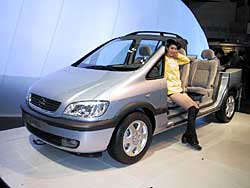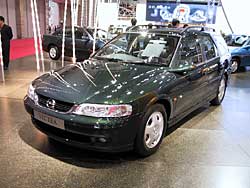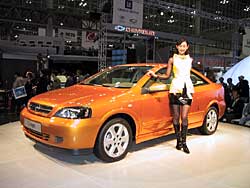
Highlights of Each Model
Zafira
 The Zafira is Opel's new-compact minivan featuring a unique "Flex-Seven" system. Flex Seven is a seating system that allows seven people to sit comfortably in a versatile seating arrangement. The Zafira, which is actually equipped with three rows of seats, allows you to arrange the interior space according to your needs without having to remove each seat individually. Considering the minivan's convenient body size as well, it is expected to be very popular even with Japanese customers who have very stringent requirements for space utilization. In Europe, it has only been on sale since April of this year. However, Opel has already received more than 120,000 orders. The mainstay engine is the 1.6/1.8-liter ECOTEC 4-cylinder units already found in the Astra. The 1.8-liter model, with four-speed automatic transmission and right-hand drive, will be soon available in the Japanese market.
The Zafira is Opel's new-compact minivan featuring a unique "Flex-Seven" system. Flex Seven is a seating system that allows seven people to sit comfortably in a versatile seating arrangement. The Zafira, which is actually equipped with three rows of seats, allows you to arrange the interior space according to your needs without having to remove each seat individually. Considering the minivan's convenient body size as well, it is expected to be very popular even with Japanese customers who have very stringent requirements for space utilization. In Europe, it has only been on sale since April of this year. However, Opel has already received more than 120,000 orders. The mainstay engine is the 1.6/1.8-liter ECOTEC 4-cylinder units already found in the Astra. The 1.8-liter model, with four-speed automatic transmission and right-hand drive, will be soon available in the Japanese market.
Omega
 Opel's flagship, the Omega, has undergone major improvements in the form of new design and performance. Over 3000 components, or more than one-third of the total parts, have been completely redesigned or improved for the New Omega. The New Omega was first displayed at the recent Frankfurt Motor Show, so this is the first chance to see the new vehicle in Japan, As with previous models it is available as a four-door sedan or station wagon. It features a 2.5-liter or 3.0-liter V6 ECOTEC DOHC 24-valve engine, and all vehicles sold in Japan have four-speed automatic transmission. Furthermore, active headrests are available as standard equipment in all vehicles, in order to minimize the risk of whiplash in a rear-end collision.
Opel's flagship, the Omega, has undergone major improvements in the form of new design and performance. Over 3000 components, or more than one-third of the total parts, have been completely redesigned or improved for the New Omega. The New Omega was first displayed at the recent Frankfurt Motor Show, so this is the first chance to see the new vehicle in Japan, As with previous models it is available as a four-door sedan or station wagon. It features a 2.5-liter or 3.0-liter V6 ECOTEC DOHC 24-valve engine, and all vehicles sold in Japan have four-speed automatic transmission. Furthermore, active headrests are available as standard equipment in all vehicles, in order to minimize the risk of whiplash in a rear-end collision.
Vectra
 Just like the Omega, Opel's middle-range car, Vectra, has also undergone major improvements. This is also the first time for the new Vectra to be shown in Japan. It is available in four-door sedan and station wagon. It is equipped with 1.8-liter or 2.0-liter ECOTEC 4-cylinder DOHC 16-valve engines, as well as a 2.5-liter V6 ECOTEC DOHC 24-valve engine. All cars to be launched in Japan will have four-speed automatic transmission and right-hand drive.
Just like the Omega, Opel's middle-range car, Vectra, has also undergone major improvements. This is also the first time for the new Vectra to be shown in Japan. It is available in four-door sedan and station wagon. It is equipped with 1.8-liter or 2.0-liter ECOTEC 4-cylinder DOHC 16-valve engines, as well as a 2.5-liter V6 ECOTEC DOHC 24-valve engine. All cars to be launched in Japan will have four-speed automatic transmission and right-hand drive.
Astra
 The Astra was first introduced at the previous Tokyo Motor Show, and was officially launched in Japan in July of last year, becoming Opel's new-generation compact car. With advanced aerodynamic styling and a spacious interior, together with its 12-year rust protection warranty, it is a model of high quality. For this reason it has been very popular in Europe since its launch there last year, and together with the Zafira has been one of the powerhouses behind Opel's rapid progress. The body types for the Japanese market are the five-door hatchback or station wagon and a four-door sedan. It comes with 1.6-liter, 1.8-liter, and 2.0-liter 4-cylinder DOHC 16-valve engines, all of which are combined with four-speed automatic transmission. The "Coupe," which is this year's display model, is an additional model expected to be launched in Europe next spring. It has a 2.2-liter 4-cylinder or 2.0-liter turbo that is not available in other body types. The Coupe is one class above the regular Astra in both status and performance. Furthermore, the famous Italian Carozzeria, Bertone, which has had a long relationship with Opel, will be in charge of the production of the Astra Coupe.
The Astra was first introduced at the previous Tokyo Motor Show, and was officially launched in Japan in July of last year, becoming Opel's new-generation compact car. With advanced aerodynamic styling and a spacious interior, together with its 12-year rust protection warranty, it is a model of high quality. For this reason it has been very popular in Europe since its launch there last year, and together with the Zafira has been one of the powerhouses behind Opel's rapid progress. The body types for the Japanese market are the five-door hatchback or station wagon and a four-door sedan. It comes with 1.6-liter, 1.8-liter, and 2.0-liter 4-cylinder DOHC 16-valve engines, all of which are combined with four-speed automatic transmission. The "Coupe," which is this year's display model, is an additional model expected to be launched in Europe next spring. It has a 2.2-liter 4-cylinder or 2.0-liter turbo that is not available in other body types. The Coupe is one class above the regular Astra in both status and performance. Furthermore, the famous Italian Carozzeria, Bertone, which has had a long relationship with Opel, will be in charge of the production of the Astra Coupe.
Vita
 The Vita is an international standard for small cars and has been a long-selling Opel car both in Japan and Europe. It boasts a comfortable interior that can accommodate four passengers of 180 cm in height within a body length of 3.8 m. At the beginning of this year, it was given new-generation 4-cylinder engines with a capacity of 1.2-liter, 1.4-liter, or 1.6-liter. It is available in three-door and five-door hatchbacks. Furthermore, a specially equipped Vita is being exhibited as the "Yellow Special" at this year's Tpkyo Motor Show.
The Vita is an international standard for small cars and has been a long-selling Opel car both in Japan and Europe. It boasts a comfortable interior that can accommodate four passengers of 180 cm in height within a body length of 3.8 m. At the beginning of this year, it was given new-generation 4-cylinder engines with a capacity of 1.2-liter, 1.4-liter, or 1.6-liter. It is available in three-door and five-door hatchbacks. Furthermore, a specially equipped Vita is being exhibited as the "Yellow Special" at this year's Tpkyo Motor Show.
G90(Display model)
 The G90, which is a new concept car by Opel with the same measurements as an Astra-class car, features superior aerodynamics, a drag coefficient of just 0.22, and a minimal body weight of 750 kg. This affords the G90 phenomenal fuel-efficiency, achieving 3.88 L/100 km in the standard European test. This also translates into an emissions level of just 90 g of CO2 per kilometer driven, and provided the car with its name, G90. The G90's amazing drag coefficient of 0.22 is a result of the unique droplet body shape developed by Opel designers. The rearward sloping roof, the noticeably tapered body width at the back, and the sharply cropped tail, allow the air to flow rapidly around the car while it is in motion. The design is very effective in reducing air resistance. Inside, the G90 accommodates basically four people. However, this is a result of reducing the width of the rear tread compared to the front, and there are two individual seats in the back. Nevertheless, the G90 provides ample room for four passengers, and the capacity of the load compartment ranges from 350 to 980 L, a very competitive level of cargo space for a hatchback car of the compact class.
The G90, which is a new concept car by Opel with the same measurements as an Astra-class car, features superior aerodynamics, a drag coefficient of just 0.22, and a minimal body weight of 750 kg. This affords the G90 phenomenal fuel-efficiency, achieving 3.88 L/100 km in the standard European test. This also translates into an emissions level of just 90 g of CO2 per kilometer driven, and provided the car with its name, G90. The G90's amazing drag coefficient of 0.22 is a result of the unique droplet body shape developed by Opel designers. The rearward sloping roof, the noticeably tapered body width at the back, and the sharply cropped tail, allow the air to flow rapidly around the car while it is in motion. The design is very effective in reducing air resistance. Inside, the G90 accommodates basically four people. However, this is a result of reducing the width of the rear tread compared to the front, and there are two individual seats in the back. Nevertheless, the G90 provides ample room for four passengers, and the capacity of the load compartment ranges from 350 to 980 L, a very competitive level of cargo space for a hatchback car of the compact class.

